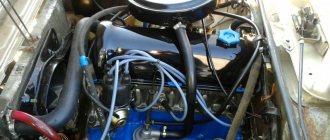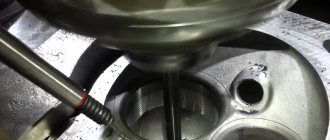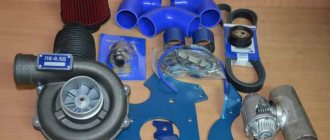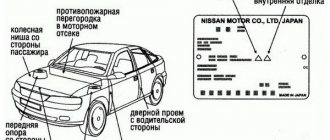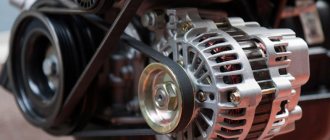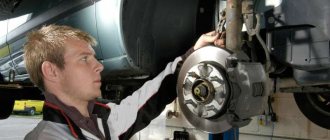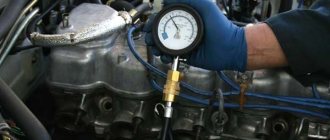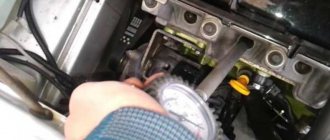Many people, mainly young guys, have enough horsepower in their car, each of them loves speed and therefore they want to add these horsepower to their engine. Therefore, our site decided to help you answer the question of how to increase engine power by telling you about almost all existing methods, and how much each of these methods will help you.
I would like to immediately clarify that if you have a small budget, then you can’t expect great achievements, yes, of course, you can achieve great results with little money, but the reliability of the motor will decrease many times over. So, let's go.
We decided to start with the most popular methods and gradually move towards less known or less used ones, for some special reasons.
Volume increase
One of the cheapest and most effective ways is to make the engine larger. This is done in the following way: the edges of each cylinder are extended to a certain distance, thereby increasing the volume in each cylinder and in the entire unit as a whole.
This procedure can be done in some tuning studio, perhaps at a service station, or you can also do it yourself. There are more horses, but high numbers won’t work there; torque also increases throughout the entire range, while reliability remains the same. This method also serves as a good start for further deep tuning, but even if it is not in your plans, it can easily be used for light tuning. If you bore the cylinders, then the intake and exhaust system will not be able to cope as perfectly as before with filling the cylinders and removing exhaust gases, and therefore the engine will become more powerful at low speeds. In order to correct this, it is necessary to make the piston stroke longer by replacing the crankshaft with a longer one, and also to reduce the total length of the piston with the connecting rod by the same length. By boring the cylinder block and raising the stroke length of the crankshaft, you can hammer out the maximum volume, although this will be expensive, but will provide a good foundation for further refinement of the engine.
Higher compression ratio
This is one of those methods that not only increases the engine performance and torque we need throughout the entire range, but also reduces the car’s fuel consumption, but at the same time we will have to switch to gasoline with a higher octane number, that is, from 95 to 98 -Ouch.
When the piston in the cylinder reaches the dead center at the top, what is located above it is called the combustion chamber and the larger its volume, the higher your compression ratio, and accordingly the power. It should be immediately clarified that the degree of compression and compression are different things, stereo compression is a geometric value, and compression is a dynamic value.
In order to increase the compression ratio, you can use two methods, the first of which is to purchase pistons with a larger diameter and, accordingly, bore the cylinders for them. As a result, you get a higher volume and compression ratio, thereby getting a plus thanks to two tuning methods.
The second option is to install a thinner cylinder head gasket. This method will give results, but there are more problems with it, since many details will need to be adjusted for such a change.
This is the result you can get:
- from 8 to 9 = 2.0%;
- from 9 to 10 = 1.7%;
- from 10 to 11 = 1.5%;
- from 11 to 12 = 1.3%;
- from 12 to 13 = 1.2%;
- from 13 to 14 = 1.1%;
- from 14 to 15 = 1.0%;
- from 15 to 16 = 0.9%;
- from 16 to 17 = 0.8%.
Also, if you greatly increase the compression ratio, these results add up, that is, increasing from 8 to 17 will give 11.5%. Also, do not forget that from a compression ratio of 12 you already need 98th gasoline, and from 13.5 you already need 102nd, from 15 105th, which is very rare and expensive. Some engines do not require a fuel change.
Reduced input resistance
Without air, the engine will immediately stall - everyone knows this. And since it is quite difficult for air to get to the combustion chambers, it is worth making its path easier.
There are several possible options here - installing a zero-resistance air filter, as well as polishing the intake manifold channels. Many modern engines have a plastic intake manifold - there is not much to polish there.
A zero filter is also not good for the motor. Although its resistance to air passage is lower than that of standard air filters, this is achieved with reduced filtering properties. In other words, the lower the air and power resistance, the more dust and dirt there is inside the internal combustion engine.
Tuning the intake system
Improving the intake is a reduction in the resistance of the incoming air into the cylinders. This is not a very complicated modification, but it requires changing or adding a large number of details, which together will give a good result.
Nulevik
The first thing you need to do is install a zero-resistance filter, which will greatly reduce air resistance, since the standard filter has a filter element made of very dense material, and the design of the filter itself does not allow a large amount of air to enter. Just above the link you can read more about Nulevik, how to install it and what results you can get from it. I would like to say right away that by installing only the zero gear, the engine power will not increase significantly, so it should be installed only with comprehensive engine tuning.
A throttle valve of increased diameter is also a necessary replacement for complex tuning. You won’t get much results from this part, but for complex modifications this part is simply necessary, as it reduces the speed of incoming air, thereby increasing the performance of the intake system. You can also find out more about this improvement using the link above.
Installing or replacing the receiver
For better engine power, the receiver has a large volume and short intake pipes. Installing this part gives a good result and therefore it can be installed even with minor modifications to the engine. This part smoothes out air pulsations. Due to the fact that the intake pipes are short, the maximum filling of the cylinders shifts to higher speeds, thereby horses and torque become greater only at high speeds, and decrease slightly at low speeds. You can ensure that only the torque at low speeds increases, but at the same time the engine thrust throughout the entire range will become less.
You can also install an intake system in which the geometry of the channels changes so that the cylinders are filled with air ideally throughout the entire range, based on data on revolutions and throttle opening. This will be the most ideal, but at the same time expensive option.
No intake manifold
Sometimes the intake manifold is removed, and instead of it, so-called pipes are installed, which are tuned to high speeds. This allows you to greatly increase the amount of air entering the engine, also reduces idle speed and improves stability at low and medium speeds. At high speeds, of course, everything becomes simply gorgeous.
This is the most difficult thing in tuning the intake of naturally aspirated engines, but at the same time it is the most effective and expensive option. You can also install multiple throttle valves, thereby improving the response to the gas pedal. Unfortunately, as a result, the service life of your engine is reduced and fuel consumption increases quite significantly.
Origin of horses: how to boost a naturally aspirated engine correctly
Two words about power
In such a question it is impossible without a pinch of theory, so let me say a few words about the nature of power so that the meaning of any “hardware” modifications is clearer. I dwelled on this issue in detail in one of the previous materials , but here I will only briefly outline the essence.
Power for any internal combustion engine can be expressed as torque times rpm, with a factor. Don’t worry, the output is still the same work per unit of time, it’s just that it’s much more convenient to operate with numbers from the technical characteristics of the machine.
Therefore, it is obvious: to increase power you need to increase torque and speed. Well, or one of these parameters.
In words, the task looks simple. It would seem, what difference does it make, 5 thousand revolutions or 8? In practice, the dependence of the loads on the cylinder-piston group on the speed is quadratic. To put it simply, you cannot recklessly increase the operating speed - the engine will quickly suffer irreversible mechanical damage. Therefore, you need to either “sharpen” the engine at high speeds , or still go by increasing the torque.
In the photo: Koenigsegg Regera, power: 1,100 hp, maximum torque: 1,280 N*m at 4,100 rpm
Articles / Practice What is more important for acceleration – power or torque? This question is one of the main topics of “holivars” on automobile forums. Opponents are ready to tear each other apart, citing dozens of arguments. But everything is simple: power is mome... 376668 6 71 02.02.2015
A little about the nature of torque
It's not that simple with him either. When the torque increases, the load on the piston group no longer increases quadratically, but linearly, but the load increases differently. The crankshaft, connecting rods, piston pins and the cylinder block itself are more heavily loaded.
Okay, let's increase the torque carefully. What needs to be done for this? “Drive” more air into the engine to oxidize more fuel. As you know, to burn one kilogram of gasoline you need 14.7-15 kilograms of air. In terms of liters, this looks much more impressive: 1.4 liters of gasoline versus 12 cubic meters, or 12 thousand liters of air. Therefore, as you understand, it is not so difficult to supply the required amount of gasoline to the engine as to provide it with air.
Therefore, torque will depend on the amount of air supplied to the cylinder per stroke, and power will depend on how much the engine can digest per unit time.
The conclusions suggest themselves: to boost, you need to either increase the working volume or apply supercharging!
Torque and volume
It just so happens that for almost any naturally aspirated engine there is a rule of thumb: 85-100 Newton meters per 1 liter of displacement. A 1.6-liter engine will have 140-160 Nm, a two-liter engine will have 180-200. This is the actual limit.
This rule is quite universal and applies to engines both old and completely new. Powerful and very weak. Unless very old engines deviate from it. Here is the MeMZ-968, an engine from Zaporozhets, its displacement is 1.2 liters, the torque is 80 Nm. But at the same time, the VAZ-2101 is the same 1.2 liters, but already 87 Nm. And these are old carburetor engines with absolutely terrible characteristics of the power supply and ignition system by modern standards!
Articles / History Why modern motors break down more often than old and proven ones In our article about the most reliable motors, modern engines are almost never found. Moreover, among those that are better not to take, the majority are new. Coincidence? Don't think. 228575 14 121 02/23/2015
The modern Skoda Fabia 1.2 engine already produces 112 Nm. Toyota's 1ZZ-FE produces 171 Nm with a 1.8-liter volume, and the much more powerful 2ZZ-GE produces only 180 Nm. The Mercedes M111 2.3 liter produces 220 Nm, and the much newer and more powerful M272 3.0 produces exactly 300 Nm. The extremely boosted Honda K20A 2.0 has a torque of 215 Nm - slightly better than “average”. And so on.
By the way, even 2.4 naturally aspirated formula engines had a torque of around 260 Nm. At a speed of 18 thousand, this was enough to obtain very high power.
The reason for such a small spread in “torque boost” is precisely that it depends on the degree of filling, piston area and piston stroke. The degree of filling is limited by atmospheric pressure and a little more can be squeezed out due to a well-designed intake system. Therefore, it is not only impossible to greatly increase the torque without increasing the displacement, it is simply not necessary.
Turbocharged engines do what they want. Do you want 250 Nm from a 1.4 engine? Please, the 1.4 TSI EA111 engine in the Skoda Octavia can do this. On the Fabia RS the same engine is more powerful, but the torque is the same. And on Mercedes, the M274 2.0 DE20 AL engine can have either 350 Nm or 370. In general, any options are possible. The turbine will inflate as much as the mechanical part of the engine can withstand.
In the photo: M274 engine, power: 245 hp, torque: 370 N*m at 1,300-4,000 rpm
The main conclusion to be drawn is that without supercharging there is no torque. Even the most dramatic changes will only produce small gains. And then mostly at high speeds.
I will talk in detail about boosting turbo engines in the next article. But if you are an opponent of turbines and still decide to “finish” your naturally aspirated engine, let’s move on. What is going on with the engine that from a naturally aspirated 1.6 of some Fiesta they get 180-220 horsepower without any supercharging, and the power of a modest two-liter turbocharged engine exceeds 400 or even 800 horsepower? And what will have to be changed in your completely ordinary engine so that it produces at least 180-200 “horses”? Globally, everything seems to be clear: either “blow” in the name of momentum, or “twist” in the name of revolutions. What will have to be changed in the design to achieve fantastic results?
Hardware work
Even if the engine remains naturally aspirated, there is a lot of hassle. Increasing operating speed is a complex and costly matter. First of all, care is taken to ensure that the piston group can withstand the load at all. The improvements go in two directions: they increase strength and at the same time reduce the weight of the piston group.
We need: forged crankshaft, forged H-shaped connecting rods, low-height T-shaped pistons, extra strong connecting rod bolts. Well, a more efficient oil pump will reduce losses and ensure acceptable strength. In particularly high-performance engines for racing, the piston may be left with only two piston rings to reduce weight, and to reduce friction losses they are made to a minimum thickness.
If your plans are for revolutions over 10 thousand per minute, the connecting rods will have to be made of titanium alloys, although this is not the best material for engine parts. Despite their high strength, its alloys are too ductile, and in internal combustion engines the manufacturing accuracy goes to microns. A very high load falls on the lower head of the connecting rod, and therefore the requirements for their studs or bolts are very high, and tuning parts are extremely expensive for this very reason.
Articles / Practice Extra horses: dangerous and pointless chip tuning of naturally aspirated engines Many car enthusiasts have heard about a wonderful way to increase engine power. All you need to do is change the control program - and immediately the machine will gain a lot of power and begin to “bullet” like... 118689 21 34 03/16/2016
Of course, the changes are not limited to the new piston group. The requirements for the timing mechanism are also growing. As the speed increases, the elasticity of the valve springs must increase so that they have time to return the plates to the closed position. Here it is necessary to reduce the mass of the valves, and at the same time their heat transfer capabilities. In addition, with more aggressive camshafts, the speed of valve opening and closing increases, and the load on all components of the mechanism increases. In general, valves are usually replaced with lightweight and especially durable ones. Titanium parts are occasionally used here, but more often high-strength steel and cermets are used.
Well, the next question is to adjust the resonance phenomena at the intake and exhaust of the engine using the intake manifold, exhaust and camshafts. Of course, they expand the “bottlenecks” in the form of a throttle, or even switch to a multi-throttle intake, with a separate valve for each cylinder.
If you act wisely, the shape of the channels in the cylinder head and other places in the intake tract usually also requires optimization. To do this, the engine is “blowed out” and pressure loss points are looked for - places with increased resistance to air flow. In practice, the processes of modifying the intake are no simpler than modifying the piston group of the engine, and with “light” tuning they completely eat up the bulk of the modification budget.
Here, for example, is the Opel C20XE engine. The engine was modified by Lotus specialists and is a typical example of a “homologation engine” - an engine that was initially prepared for modifications by the manufacturer itself. It’s not for nothing that it was used in the WTCC by the Opel team, and then Chevrolet and Lada for a good fifteen years. Its design can withstand forcing quite well, and therefore the list of necessary changes looks quite modest.
With an initially less “durable” engine, the budget would be higher, and many times higher. The stock C20XE has a displacement of 2.0 liters and a power of 150 hp. With. English companies have gained a lot of experience in preparing this engine for various races and there are so-called “whales” that you can buy and install on your engine. Of course, the engine must be perfectly assembled and not have significant wear. For example, let's use the products of the Qedmotorsport company.
Each modification kit includes an intake manifold with individual throttles for each 45 mm diameter cylinder, a new fuel pressure regulator, a fuel rail, a new engine control system (ECU), a two-stage maximum rev limiter and comes complete with a wiring kit. The system is homologated for use in motorsports.
The minimum level of modifications guarantees a power of 190-200 hp. With. when installing camshafts with high cam heights and stronger connecting rod bolts. The price of such a kit is 1,800 pounds. Not on a budget, but everything was calculated not in a garage, but by professionals.
Want more? Set of modifications C20XE up to 210 hp. With. includes replacement pistons for operation at higher speeds, split timing gears for fine-tuning timing and even more “aggressive” camshafts. The price of such a kit is already 2,300 pounds.
To get another 10 hp. on top, with a power limit of 215-220 hp, the kit receives new camshafts designed to operate without hydraulic compensators, new pushers, new valve springs. The price of such a kit is already 2,550 pounds.
The top kit, with a maximum output of up to 245 hp, includes the same kit as the previous one, but tuned for higher speeds and loads. Price: £2,750. The finished engine with a stand certificate for 240-260 hp. has a price of about 3,500-5,000 pounds, depending on the manufacturer.
The maximum power level that factory racing teams had with such an engine was about 280-320 horsepower with an unlimited budget.
Another example is the 2.0 Duratec engine, which is very popular in the Fiesta and Focus rally cars. The same 2 liters and 150 hp, but a more modern design. For example, let's take the English modifications of Omex Technology Systems.
Motor with a set of modifications up to a power of 180 hp. costs £5,995 excluding sales tax. The kit includes a new intake manifold with custom intake piping and throttle bodies, control system, evil camshafts, heavy-duty connecting rod bolts and exhaust system. Maximum revolutions are 7,800 per minute, maximum power is achieved at 6,500.
Motor with a set of modifications up to 200 hp. With. includes modifications to the cylinder head and combustion chambers. The price of such a motor is 6,895 pounds excluding taxes. Maximum power is achieved at 7,000 rpm.
The maximum level of modification up to a power of 260 horsepower includes forged pistons for the highest loads, H-shaped forged connecting rods, more elastic valve springs and a timing relief kit, more efficient injectors and other modifications. Maximum rpm 8,700, maximum power at 8,500 rpm. The price of such an engine is already 11,595 pounds.
In general, as you can see, correct “atmospheric tuning” is quite expensive, difficult, and the output is not exactly stunning.
Effect
Even with a small increase in maximum speed, you can significantly increase power if you reduce the torque drop or even slightly increase it at maximum rotation speed.
While maintaining the amount of torque by transferring it to the higher speed zone, you can get an increase in power by 30-40%. In fact, it is the restructuring of the intake that is the key to high power of an atmospheric engine, and the limitation here is the capabilities of the piston group.
Design limit
The higher the degree of boost of the naturally aspirated engine, the more effort needs to be applied. Revs up to 7 thousand do not require much effort if the maximum of the stock engine was at 6 thousand.
Every thousand revolutions in excess comes at a high price. All elements must become lighter and stronger, and this is not just difficult, but very difficult to combine. Already 10 thousand revolutions for a standard piston group of a typical “square” engine is an unattainable dream. Most highly boosted engines are limited to 8,500-9,000 rpm. Particularly short stroke designs may attempt to achieve higher RPMs. For example, small motorcycle engines feel quite good at speeds above 13 thousand, but it is unrealistic to boost a “civilian” car engine to such an extent.
All tricks are useless; losses in the piston group increase too quickly. And even serious modifications to the timing mechanism to increase efficiency will no longer help, although there is still a way to go for motorcycle and racing short-stroke ones. Let's say there is such a thing as a desmodromic valve mechanism, where springs are not used - they withstand extremely high speeds. But this is expensive and unjustified - now such a mechanism is used only on Ducati motorcycles, and mainly for the sake of image. And on formula machines they used “pneumatic springs” of the valves, allowing them to “play” with elasticity over a wide range.
In a word, I will repeat once again what has already been said above. It is impossible to seriously increase engine power without using one or another boost. I will talk about “supercharged tuning” in the second part of the story about boosting.
Survey
Have you ever tried to boost a naturally aspirated engine?
Your voice
Total votes:
Exhaust system tuning
As soon as you increase the amount of force, the flow of exhaust gases exiting through the exhaust pipe immediately increases, and the standard exhaust system cannot cope with this and therefore creates excess resistance. If the exhaust is not suitable, the pressure in the cylinders can increase, causing the pumps to work more efficiently. Also, due to the fact that the exhaust system cannot cope, the cylinder may be poorly filled with the mixture, since not all exhaust gases have left the cylinder space.
The shorter and larger the diameter of the exhaust pipe, the less resistance. If your unit has a volume of 1.5 and it allows you to constantly turn it above 8 thousand, which you constantly do, then a pipe with a diameter of about 50 millimeters is enough for you, if the length is a maximum of 3.5 meters.
Often a spider is used as a replacement for the manifold, which works great for its intended purpose, as well as increasing power and torque throughout the entire range. In most cases a 4-2-1 spider is used, but sometimes a 4-1 is used. You can find out more at the link above. A direct-flow exhaust can also improve the exhaust system.
Accessories
Here's another way to increase engine power. To do this, you need to select high-quality components for the engine. It has long been known that the filter, spark plugs, wires and everything else can significantly affect power. Some manufacturers produce high-quality products, while others produce low-quality products.
If you replace everything at once, then on a standard VAZ engine you can increase the power by up to 5%. But the higher the rating of the components that were used on the car assembly line, the less results can be achieved.
Chip tuning
A fairly common type of engine modification, which is used both for complex tuning and is used as the only source of new “fillies”. Chip tuning is the tuning of a microcircuit; more precisely, it is the calibration of the microprogram of the vehicle's electronic control unit (ECU).
Manufacturers for their cars set a certain ignition timing for different regions, most often it is too wide due to which the fuel does not burn so efficiently. The manufacturer also sets high adjustments to the ignition timing in order to reduce the load on the transmission, but unfortunately during acceleration the engine is more thoughtful and has dips. Also, due to the factory settings, the car may have increased fuel consumption.
Thanks to chip tuning, you can eliminate all problems and thereby achieve a more pleasant driving experience, as well as increase torque, strength and reduce fuel consumption. As a result, it turns out that this type of tuning is relatively cheap, does not require intervention or any technical changes, which will leave the car under warranty and at the same time give good results. Chip tuning is necessary if you change the technical part of the engine, since it must be adjusted to the changed characteristics obtained by installing any part. Good results only thanks to chip tuning were obtained by sports cars with high performance characteristics, so if your car is weak, then do not expect any high results from this modification.
There are no downsides to this type of modification, but most importantly, this type of work is best done by a person who understands this, so do not spare money on the service.
ICE heating
Here's another way to increase power on a VAZ. It is known that the hotter the engine, the higher its efficiency. Naturally, overheating should not be allowed, but if you change the temperature insignificantly by reconfiguring the thermostat, you can get good results.
The same was achieved by abandoning drive fans in cooling systems in favor of electric ones. The fan did not always work, but only when necessary, significantly accelerating the heating of the internal combustion engine and increasing efficiency, and, accordingly, power.
Lightweight flywheel and forged pistons
A lightweight flywheel is installed on tuned cars quite often, as it gives good results with a comprehensive modification of the engine. The bottom line is that a lightweight flywheel is lighter (no matter how it sounds), so it spins up faster and reaches maximum speed faster. As a result, it turns out that the engine power increases, but the maximum you can get is 4% from the previous one.
Replacing this part is not difficult, so anyone can make this modification. Such a flywheel costs an average of 2-4 thousand rubles, depending on the car. If you do not plan to greatly increase the indicator we need, then this type of modification will suit you along with a zero-resistance filter, chip tuning, compression and other light modifications, which together will give a good result for enjoying the speed characteristics of the car.
Forged pistons are very often installed by many tuning enthusiasts, and racing drivers also leave positive reviews about them. The bottom line is that a forged piston moves easier due to its lighter weight, and it will also withstand higher temperature loads because it is stronger.
Replacement of standard engine parts with sports analogues
The essence of this improvement is to replace standard engine parts with sports analogues. For example, forged pistons can increase the permissible loads placed on the engine. In other words, this improvement allows you to get the most out of any engine and achieve the required increase in power. However, be prepared to replace the gearbox and brakes, which also need to be adapted to the new loads.
The advantages of this method include maintaining the same fuel consumption and extending the service life of the engine through the use of higher quality and adapted spare parts.
Reducing friction force
You can also quite well increase the number of “horses” if you reduce the friction force between the piston and the cylinder walls. Of course, there is motor oil for this, but as a rule it is not enough, so various additives are used. Can I recommend the Suprotec additive, about which there are a lot of rumors; some are not sure how it works. Someone says that it really works, we belong to the second type of people and recommend this additive. In principle, you don’t have to trust us and use some other additive from another manufacturer, it’s your choice.
Using this method, you can achieve about a 7% increase, and also improve the reliability of the engine due to the fact that the friction force of the piston on the cylinder walls will be less. There is also a rumor that this additive reduces fuel consumption, but we have not tested this and will not confirm this rumor.
Nitrous oxide
Many have seen this in the movies. The cylinder, which is installed in the car, allows you to significantly increase power, but only for a short time. When heated, the substance is divided into nitrogen and oxygen. During combustion of the fuel mixture in the cylinders, the amount of oxygen increases to 31%. At the same time, in ordinary air the amount of O2 is only 21%. This allows you to add more fuel, squeezing extra power out of the engine. Since the nitrous oxide evaporates, it cools the air well. Its density increases, there is a lot of oxygen.
The technique is simple, but the short duration of the power increase and the high cost are a significant drawback. In Russia, some racers use this.
Camshaft
This part is often changed in order to slightly increase hp, while many people stop only at this method and eventually abandon it after some time. The shafts are the brain, but mechanical.
The task of sports camshafts is to ensure the necessary supply of mixture to the cylinders due to the higher valve lift height. There are downstream oxen designed to add hp. at low revs, there are also universal and riding ones that will increase power at high revs. In order to understand which of them does what, you need to look at how much they raise the valves, if a little, then you will get an increase at low speeds, and if the valves rise high, then, as you already understand, there will be more force at high speeds.
Installing shafts is not that difficult; those interested can read about it at the link here. Your task is to choose sports shafts for low or high speeds. Once you have installed the new shafts, your task is to adjust the valves using the split gear.
Reduced mechanical losses
Not even the most modern and technologically advanced internal combustion engine will ever be able to produce its maximum power if a large share of the energy is spent on overcoming mechanical losses. It is impossible to completely get rid of these losses, but they can be significantly reduced. It is for this purpose that manufacturers produce lightweight piston group parts - pistons and connecting rods with the same dimensions of spare parts.
Such kits can be purchased. They are offered in tuning stores. They are readily purchased by amateurs and professionals. Due to the lightweight piston engine, it is easier to spin up. This is the first option that helps increase the power of VAZ with minimal investment.
Installation and replacement of turbocharging
Using turbocharging is one of the best ways to increase horsepower, as this method gives very high results. You can often find turbocharged ]VAZ[/anchor] cars.
So, first for those whose car is already turbocharged from the factory. In fact, there are quite a lot of such cars, especially since modern manufacturers have recently increasingly made 1.4-liter turbo engines, but there are also other turbo engines. If your unit is already equipped with turbocharging, then you can significantly increase the hp. by installing a larger turbine or increasing the pressure of a standard turbine. There are detailed articles on the Internet about how to increase blood pressure. Replacing a turbine with another one will also not be difficult; removing the old one and putting a larger one in its place is not so difficult.
Regarding the installation of turbocharging on an initially naturally aspirated car, this is a more complicated procedure. You should immediately understand that the operation of your car will be somewhat different, since you will have to clean the oil and air filters more often, and you will constantly have to warm up the installation, even in warm weather.
After installing the turbine, the characteristics may change by 2 times, or even more, it all depends on your hands, the size and pressure of the turbine. You must also understand that simply installing a turbine will not work, since it heats up and the entire engine heats up with it and therefore it needs to be cooled somehow, so turbo engines almost always have an intercooler, but it is possible and even desirable to increase the amount flow of coolant into the radiator, radiator ventilation, fan performance. Also, in addition to simply installing a turbine, it is also necessary to install more efficient injectors. There is also such a thing as turbo lag.
Installing a zero resistance air filter.
Such a filter, or “nulevik”, has minimal air resistance.
“Zero” air filter:
The standard air filter element is made of a dense porous material that creates significant resistance. That is, the design of this part itself does not allow more air to be delivered to the engine. To get around this limitation, special filters made of thin, lightweight materials are used.
Important: by installing a zero-resistance air filter alone, it will not be possible to achieve any significant increase in the power of the air engine; the operation should be performed only as part of a comprehensive engine modernization.
Be sure to install a throttle valve with a larger diameter in parallel with the filter.
Results
As you understand, there are many ways that can increase engine power, but easy methods will not give good results, and refinement methods that give good results require complex work and additional improvements. You must understand that all parts of the car are calculated approximately for its entire components. That is, the gearbox and suspension are able to withstand all the data and most often have a small margin, but the manufacturer will not do this for a 100 hp engine. A gearbox capable of withstanding 1000 hp does not make sense. Therefore, if you decide to seriously tune your power plant and achieve high performance, then your task, firstly, is not to stop at one method, but to use everything, and secondly, to improve the stability of the gearbox, suspension and engage in engine cooling.
In this article we have listed the most basic and most popular methods of engine tuning, and we hope that we have answered your question in sufficient detail. Of course, there are still different ways to modify the motor, but they are rarely used for certain reasons. If you think that we have missed some method, then write to us by email and we will add this method to the article, also share the article with your friends and love your cars.
Direct flow installation
How else can you increase the power of a VAZ engine? It is enough to install a straight-through exhaust pipe. You can increase the power characteristics by 15%. At the same time, the costs are insignificant and consist of installing a direct-flow pipe in the exhaust system.
The straight-through pipe will reduce the resistance of the exhaust gases, which will significantly speed up their exit. The engine's costs for exhaust gases are reduced, and all the energy that was saved is redirected to rotating the crankshaft. As a payment (and you have to pay for everything), the driver will receive unpleasant noise, dirty and unenvironmentally friendly exhaust.
